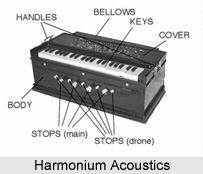 Harmonium acoustics are essential to producing the great music that this musical instrument actually does. The acoustical effects in harmonium are a result of the free-reed mechanism. Therefore, they are essentially identical for the Western and Indian harmoniums and the reed organ.
Harmonium acoustics are essential to producing the great music that this musical instrument actually does. The acoustical effects in harmonium are a result of the free-reed mechanism. Therefore, they are essentially identical for the Western and Indian harmoniums and the reed organ.
History of Acoustics
In 1875, Hermann von Helmholtz published his seminal book, On the Sensations of Tone, in which he used the harmonium extensively to test different tuning systems: Using two manuals and two differently tuned stop sets, he was able to simultaneously compare Pythagorean to just and to equal-tempered tunings and observe the degrees of inharmonicity inherent to the different temperaments. He subdivided the octave to 28 tones, to be able to perform modulations of 12 minor and 17 major keys in just intonation without going into harsh dissonance that is present with the standard octave division in this tuning. This arrangement was noted to be difficult to play on. Additional modified or novel instruments were described to be used for experimental and educational purposes were described. In practice, that harmonium was constructed with 84 keys, for convenience of fingering. Another famous reed organ that was evaluated was built by Poole.
Lord Rayleigh also used the harmonium to devise a method for indirectly measuring frequency accurately, using approximated known equal temperament intervals and their overtone beats. The harmonium had the advantage of providing clear overtones that enabled the reliable counting of beats by two listeners, one per note. However, Rayleigh acknowledged that maintaining constant pressure in the bellows is difficult and fluctuation of the pitch occurs rather frequently as a result.
Reed organ frequencies depend on the blowing pressure; the fundamental frequency decreases with medium pressure compared to low pressure, but it increases again at high pressures by several hertz for the bass notes measured. American reed organ measurements showed a sinusoidal oscillation with sharp pressure transitions when the reed bends above and below its frame. The fundamental itself is nearly the mechanical resonance frequency of the reed. The overtones of the instrument are harmonics of the fundamental, rather than inharmonic, although a weak inharmonic overtone (6.27f) was reported too. The fundamental frequency comes from a traverse mode, whereas weaker higher traverse and torsion modes were measured too. Any torsion modes are excited because of a slight asymmetry in the reed`s construction. During attack, it was shown that the reed produces most strongly the fundamental, along with a second transverse or torsion mode, which are transient.
Radiation patterns and coupling effects between the sound box and the reeds on the timbre appear not to have been studied to date. The unusual reed-vibration physics have a direct effect on harmonium playing, as the control of its dynamics in playing is restricted and subtle. The free reed of the harmonium is riveted from a metal frame and is subjected to airflow, which is pumped from the bellows through the reservoir, pushing the reed and bringing it to self-exciting oscillation and to sound production in the direction of airflow. This particular aerodynamics is nonlinear in that the maximum displacement amplitude in which the reed can vibrate is limited by fluctuations in damping forces, so that the resultant sound pressure is rather constant. Additionally, there is a threshold pumping pressure, below which the reed vibration is minimal. Within those two thresholds, there is an exponential growth and decay in time of reed amplitudes
As far as its construction is concerned, the Indian harmonium`s departure from its European predecessors is insignificant. Modifications to the instrument mostly involved its general ease of use (e.g. making it playable by someone sitting on the floor) or timbre (experiments with reeds) - important, yet unproblematic aspects. Another issue seems to be critical, though: the harmonium`s tuning. Early harmoniums were usually tuned to equal temperament way into the 20th century, and this tuning system was only abandoned when the Second World War reduced the influx of European instruments to a trickle, making space for a burgeoning local harmonium industry.




